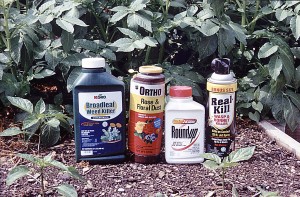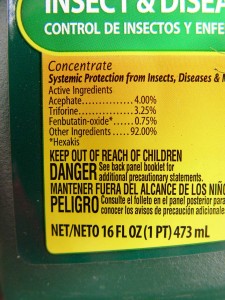Top 10 Reasons Why You Really Should Read the Pesticide Label
I seldom use pesticides of any kind.
For one thing, I don’t like spending the money. It’s usually cheaper to just replace an ailing plant than to have to spray it repeatedly year in and year out with a $20 bottle of something.
Second, it’s just way too complicated figuring out what product works best against which bugs and disease and at which time.
But for those of you who DO use insecticides, fungicides, miticides, herbicides and any other cides, I appeal to you to first read the label.
There’s some very important information on them, even if it is in print size that’s smaller than the mites you’re trying to kill.
I can’t claim creation of the following list, but I do agree with it. From the Weed Science Society of America, here are 10 reasons why you should read those labels before using:
1.) You may apply the wrong product… or the right product at the wrong rate. Make sure the active ingredients are effective against your particular problem. And realize that different brands may use different concentrations of the same ingredient.
2.) The label may have changed. You may have been using a product for a long time, but sometimes formulations and directions change. Read the label each new purchase.
3.) The site you are treating might not be listed on the label. You can’t apply everything anywhere. Some products are made for lawns but not flowers. Some products can’t be sprayed on edibles. Some products shouldn’t be applied near water.
4.) You might make the application at the wrong time or wrong frequency. Many herbicides, for example, don’t work at cold temperatures or when a weed has grown too large. Most products require an interval between applications so they don’t pollute or harm plants on which you’re applying them.
5.) You might find toxicity precautions beyond your comfort range. Labels read “Caution,” “Warning” or “Danger” as a measure of how acutely toxic they are in terms of ingestion, inhalation and eye and skin contact. The time to decide your tolerance and how you plan to handle them is before buying.
6.) You might not know about or have the recommended protective equipment. The label tells you whether you ought to use the product with protection such as dusk masks, gloves, safety glasses and/or long-sleeved shirts.
7.) If you’re accidentally exposed, you won’t know what to do or have the needed supplies on hand. The time to have antidotes on hand and at the ready is before you use a pesticide. You don’t want to be scrambling around in a panic trying to figure out what to do after you’re having a reaction.
8.) You won’t understand the possible hazards to people, pets and the environment. This often takes up a big chunk of a product label – the precautions needed to limit any unwanted effects to your surroundings.
9.) You won’t know how to store and dispose of the product. The biggest concern is children and pets getting into something stored unsafely that can harm them. Also a problem is pesticides dumped down sinks or discarded into landfills.
10.) You might mix products that are incompatible. Some people combine two or more products to solve multiple problems with one treatment. Sometimes one product nullifies the effectiveness of another, or worse yet, results in something toxic or harmful to plants.









